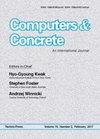PP纤维增强煤渣混凝土火灾后的粘结性能
IF 3.3
4区 工程技术
Q2 COMPUTER SCIENCE, INTERDISCIPLINARY APPLICATIONS
引用次数: 3
摘要
为了减少混凝土在火灾中的损伤,利用煤渣优异的耐火性能,研制了一种新型轻质煤渣骨料混凝土。为了进一步提高其耐火性能,还在这类混凝土中加入了可提高混凝土耐火性能的聚丙烯(PP)纤维。然而,这种新型混凝土在火灾后的粘结性能仍是未知的。为了研究其粘结行为,185个试样分别被加热到22、200、400、600或800℃,持续2小时,然后在室温下进行压缩和拉伸试验。对C30 PP纤维增强煤渣混凝土在火灾后的混凝土-钢筋粘结强度进行了拉拔试验。采用先进的扫描电子显微镜观察了PP纤维增强煤渣混凝土在不同温度下的微观结构和状态,旨在了解高温下粘结劣化的机理。根据试验结果,研究了钢筋直径和粘结长度对PP纤维增强煤渣混凝土粘结强度的影响。根据试验结果,导出了PP纤维增强煤渣混凝土在不同温度下的粘结滑移关系。本文章由计算机程序翻译,如有差异,请以英文原文为准。
Bond behavior of PP fiber-reinforced cinder concrete after fire exposure
To reduce the damage of concrete in fire, a new type of lightweight cinder aggregate concrete was developed due to the excellent fire resistance of cinder. To further enhance its fire resistance, Polypropylene (PP) Fibers which can enhance the fire resistance of concrete were also used in this type of concrete. However, the bond behavior of this new type of concrete after fire exposure is still unknown. To investigate its bond behavior, 185 specimens were heated up to 22, 200, 400, 600 or 800 oC for 2 h duration respectively, which is followed by subsequent compressive and tensile tests at room temperature. The concrete-rebar bond strength of C30 PP fiber-reinforced cinder concrete was subsequently investigated through pull-out tests after fire exposure. The microstructures of the PP fiber-reinforced cinder concrete and the status of the PP fibre at different temperature were inspected using an advanced scanning electron microscopy, aiming to understand the mechanism of the bonding deterioration under high temperature. The effects of rebar diameter and bond length on the bond strength of PP fiber-reinforced cinder concrete were investigated based on the test results. The bond-slip relation of PP fiber-reinforced cinder concrete after exposure at different temperature was derived based on the test results.
求助全文
通过发布文献求助,成功后即可免费获取论文全文。
去求助
来源期刊

Computers and Concrete
工程技术-材料科学:表征与测试
CiteScore
8.60
自引率
7.30%
发文量
0
审稿时长
13.5 months
期刊介绍:
Computers and Concrete is An International Journal that focuses on the computer applications in be considered suitable for publication in the journal.
The journal covers the topics related to computational mechanics of concrete and modeling of concrete structures including
plasticity
fracture mechanics
creep
thermo-mechanics
dynamic effects
reliability and safety concepts
automated design procedures
stochastic mechanics
performance under extreme conditions.
 求助内容:
求助内容: 应助结果提醒方式:
应助结果提醒方式:


